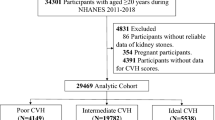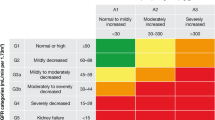Abstract
The aim of this study is to investigate whether the prediction of all-cause mortality from traditional risk factors is improved by adding electrolytes (serum-phosphate (S-P), serum-calcium (S-Ca) and serum-magnesium (S-Mg)) in a Cox regression. The study uses an 18-year follow-up of patients (n=2504) referred by physicians in primary health care and hospitals to the Vindeln Patient Education (VPE) Center, mainly with a diagnosis of hypertension (HT), type 2 diabetes mellitus (DM) and/or obesity. Cox regression, with the latest registered value and baseline values for risk factors, was used to study all-cause mortality in men and women. 221 out of 1096 men and 157 out of 1408 women died during the 18-year follow-up (20% and 11% respectively). The Cox regression analysis reveals that high blood glucose (B-Glu) and low S-Mg were significantly associated with increased all-cause mortality in the whole patient population as well as in men and women separately. Among women, type 2 DM and systolic blood pressure (SBP) and among men, high S-Ca, S-P, S-urate and body mass index (BMI) were the main predictors of all-cause mortality. There is significantly improved prediction of all-cause mortality with electrolytes added to the traditional risk factors. High B-Glu and low S-Mg in both men and women, and high S-Ca and S-P in men, are significantly associated with all-cause mortality. The metabolic disturbance in this high-risk group of patients can be more fully understood if ionic imbalance is included in the prediction of mortatlity.
Similar content being viewed by others
References
Reaven GM (1988) Role of insulin resistance in human disease. Diabetes 37:1595–1607
— (2001) Executive summary of the third report of the national cholesterol education program (NCEP). Expert Panel on detection evaluation, and treatment of high blood cholesterol in adults (Adult Treatment Panel III). J Am Med Assoc 19:248–297
Hennis A, Wu SY, Nemesure B, Li X, Leske MC; Barbados Eye Study Group (2002) Diabetes in a Caribbean population: epidemiological profile and implications. Int J Epidemiol 31:234–239
Ko GTC, So WY, Chan NN, Chan W-B, Tong PC-Y, Li J, Yeung V, Chow C-C, Ozaki R, Ma RC-W, Cockram CS, Chan JC-N (2006) Prediction of cardiovascular and total mortality in Chinese type 2 diabetic patients by the WHO definitions for the metabolic syndrome. Diabetes Obes Metab 8:94–104
Laukkanen JA, Lakka TA, Rauramaa R, Kuhanen R, Venalainen JM, Salonen R, Salonen JT (2001) Cardiovascular fitness as a predictor of mortality in men. Arch Intern Med 161:825–831
Hedblad B, Nilsson P, Engstrom G, Berglund G, Janzon L (2002) Insulin resistance in non-diabetic subjects is associated with increased incidence of myocardial infarction and death. Diabet Med 19:470–475
Zhou BF (2002) Effect of body mass index on all-cause mortality and incidence of cardiovascular diseases — report for meta-analysis of prospective studies open optimal cut-off points of body mass index in Chinese adults. Biomed Environ Sci 15:245–252
Gruberg L, Weissman NJ, Waksman R, Fuchs S, Deible R, Pinnow EE, Ahmed LM, Kent KM, Pichard AD, Suddath WO, Satler LF, Lindsay J Jr (2002) The impact of obesity on the short-term and long-term outcomes after percutaneous coronary intervention: the obesity paradox? J Am Coll Cardiol 39:578–584
Yosefy C (2003) Hyperglycaemia and its relation to cardiovascular morbidity and mortality. Has it been resolved? Acta Diabetol 40:S380–S388
Palumbo F, Bianchi C, Miccoli R, Del Prato S (2003) Hyperglycaemia and cardiovascular risk. Acta Diabetol 40:S362–S369
Janghorbani M, Hedley AJ, Jones RB, Zhianpour M, Gilmour WH (1993) Gender differential in all-cause and cardiovascular disease mortality. Int J Epidemiol 22:1056–1063
Lingfors H, Persson LG, Lindström K, Ljunqvist B, Bengtsson C (2002) Time for a “vision zero” concerning premature death from ischaemic heart disease? Scand J Prim Health Care 20:28–32
Grundy SM, Hansen B, Smith SC Jr, Cleeman JI, Kahn RA (2004) American Heart Association; National Heart, Lung, and Blood Institute; American Diabetes Association. Clinical management of metabolic syndrome: report of the American Heart Association/National Heart, Lung, and Blood Institute/American Diabetes Association conference on scientific issues related to management. Circulation 109:551–556.
Liao Y, Kwon S, Shaughnessy S, Wallace P, Huffo A, Jenkins AJ, Klein RL, Garvey WT (2004) Critical evaluation of adult treatment panel III criteria in identifying insulin resistance with dyslipidemia. Diabetes Care 27:978–983
Håglin L, Lindblad Å, Bygren LO (2001) Hypophosphataemia in the metabolic syndrome. Gender differences in body weight and blood glucose. Eur J Clin Nutr 55:493–498
Sjöström M, Karlsson AB, Kaati G, Yngve A, Green LW, Bygren LO (1999) A four week residential program for primary health care patients to control obesity and related heart risk factors: effective application of principles of learning and lifestyle change. Eur J Clin Nutr 53[Suppl 2]:S72–S77
Parmar M, Machin D (1995) Survival analysis: a practical approach. Wiley, Chichester
Schafer JL (1997) Analysis of incomplete multivariate data. Chapman and Hall, London
Leone N, Courbon D, Ducimetiere P, Zureik M (2006) Zinc, copper and magnesium and risks for all-cause, cancer and cardiovascular mortality. Epidemiology 17:308–314
Kip KE, Marroquin OC, Kelley DE, Johnson BD, Kelsey SF, Shaw LJ, Rogers WJ, Reis SE (2004) Clinical importance of obesity versus the metabolic syndrome in cardiovascular risk in women: a report from the Women’s Ischemia Syndrome Evaluation (WISE) study. Circulation 109:706–713
O’Connor LR, Wheeler WS, Bethune JE (1977) Effect of hypophosphatemia on myocardial performance in man. N Engl J Med 297:901–903
Haap M, Heller E, Thamer C, Tschritter O, Stefan N, Fritsche A (2006) Association of serum phosphate levels with glucose tolerance, insulin sensitivity and insulin secretion in non-diabetic subjects. Eur J Clin Nutr 60:734–739
Barbagallo M, Dominguez LJ, Galioto A, Ferlisi A, Cani C, Malfa L, Pineo A, Busardo’ A, Paolisso G (2003) Role of magnesium in insulin action, diabetes and cardio-metabolic syndrome X. Mol Aspects Med 24:39–52
Eichhorn EJ, Tandon PK, DiBianco R, Timmis GC, Fenser PE, Shannon J, Packer M (1993) Clinical and prognostic significance of serum magnesium concentration in patients with severe chronic congestive heart failure: the PROMISE study. J Am Coll Cardiol 21:634–640
Djurhuus MS, Skott P, Hother-Nielson O, Klitgaard NA, Beck-Nielsen H (1995) Insulin increases renal magnesium excretion: a possible cause of magnesium depletion in hyperinsulinaemic states. Diabet Med 12:664–669
Rodriguez-Morán M, Guerrero-Romero F (2003) Oral magnesium supplementation improves insulin sensitivity and metabolic control in Type 2 diabetic subjects. Diabetes Care 26:1147–1152
Resnick LM, Barbagallo M, Gupta RK, Laragh JH (1993) Ionic basis of hypertension in Diabetes mellitus. Role of hyperglycemia. Am J Hypertens 6:413–417
Touyz RM (2003) Role of magnesium in the pathogenesis of hypertension. Mol Aspects Med 24:107–136
Zoppini G, Verlato G, Lenzinger C, Zamboni C, Brun E, Bonora E, Muggeo M (2003) Body mass index and the risk of mortality in type 2 diabetic patients from Verona. Int J Obes 27:281–285
Li Y, Woo V, Bose R (2001) Platelet hyperactivity and abnormal Ca2+ homeostasis in diabetes mellitus. Am J Physiol Heart Circ Physiol 280:H1480–H1489
Lind L, Jakobsson S, Lithell H, Wengel B, Ljunghall S (1988) Relation of serum calcium concentration to metabolic risk factors for cardiovascular disease. Br Med J 297:960–963
Nussbaum T (1993) Pathophysiology and management of severe hypercalcemia. Endocrinol Metab Clin North Am 22:343–362
Hu FB, Stampfer MJ, Solomon CG, Liu S, Willett WC, Speizer FE, Nathan DM, Manson JE (2001) The impact of diabetes mellitus on mortality from all causes and coronary heart disease in women: 20 years of follow-up. Arch Intern Med 161:1717–1723
Liese AD, Hense HW, Lowel H, Doring A, Tietze M, Keil U (1999) Association of serum uric acid with all-cause and cardiovascular disease mortality and incident myocardial infarction in the MONICA Augsburg cohort. World Health Organization Monitoring Trends and Determinants in Cardiovascular Diseases. Epidemiology 10:391–397
Thomas GN, Chook P, Qiao M, Huang XS, Leong HC, Celermajer DS, Woo KS (2004) Deleterious impact of “high normal” glucose levels and other metabolic syndrome components on arterial endothelial function and intima-media thickness in apparently healthy Chinese subjects: the CATHAY Study. Arterioscler Thromb Vasc Biol 24:739–743
Author information
Authors and Affiliations
Corresponding author
Rights and permissions
About this article
Cite this article
Håglin, L., Törnkvist, B. & Bäckman, L. Prediction of all-cause mortality in a patient population with hypertension and type 2 DM by using traditional risk factors and serum-phosphate,-calcium and-magnesium. Acta Diabetol 44, 138–143 (2007). https://doi.org/10.1007/s00592-007-0254-6
Received:
Accepted:
Published:
Issue Date:
DOI: https://doi.org/10.1007/s00592-007-0254-6




